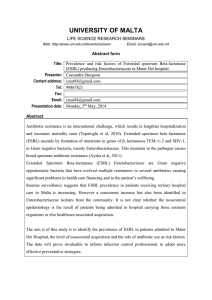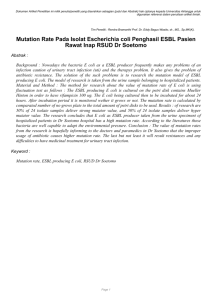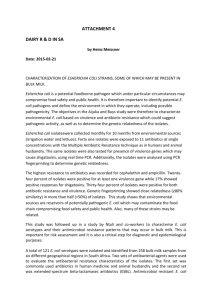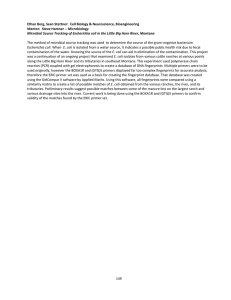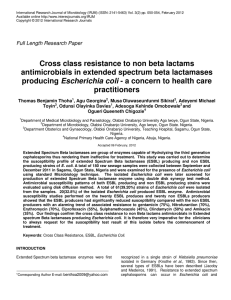Document 14104676
advertisement
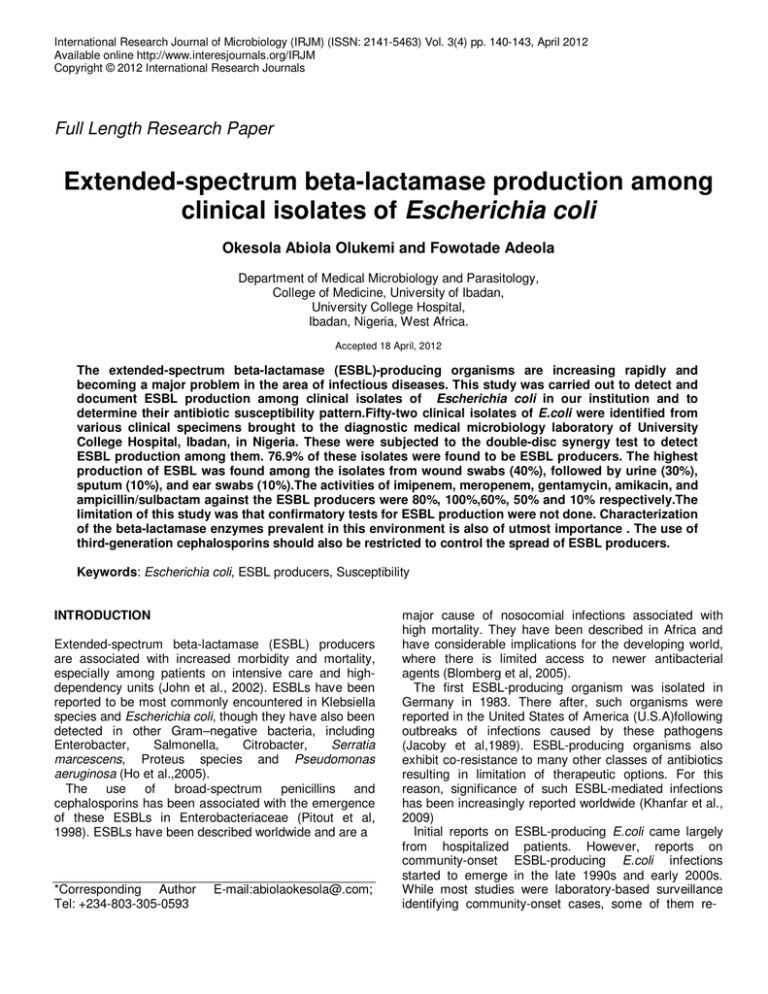
International Research Journal of Microbiology (IRJM) (ISSN: 2141-5463) Vol. 3(4) pp. 140-143, April 2012 Available online http://www.interesjournals.org/IRJM Copyright © 2012 International Research Journals Full Length Research Paper Extended-spectrum beta-lactamase production among clinical isolates of Escherichia coli Okesola Abiola Olukemi and Fowotade Adeola Department of Medical Microbiology and Parasitology, College of Medicine, University of Ibadan, University College Hospital, Ibadan, Nigeria, West Africa. Accepted 18 April, 2012 The extended-spectrum beta-lactamase (ESBL)-producing organisms are increasing rapidly and becoming a major problem in the area of infectious diseases. This study was carried out to detect and document ESBL production among clinical isolates of Escherichia coli in our institution and to determine their antibiotic susceptibility pattern.Fifty-two clinical isolates of E.coli were identified from various clinical specimens brought to the diagnostic medical microbiology laboratory of University College Hospital, Ibadan, in Nigeria. These were subjected to the double-disc synergy test to detect ESBL production among them. 76.9% of these isolates were found to be ESBL producers. The highest production of ESBL was found among the isolates from wound swabs (40%), followed by urine (30%), sputum (10%), and ear swabs (10%).The activities of imipenem, meropenem, gentamycin, amikacin, and ampicillin/sulbactam against the ESBL producers were 80%, 100%,60%, 50% and 10% respectively.The limitation of this study was that confirmatory tests for ESBL production were not done. Characterization of the beta-lactamase enzymes prevalent in this environment is also of utmost importance . The use of third-generation cephalosporins should also be restricted to control the spread of ESBL producers. Keywords: Escherichia coli, ESBL producers, Susceptibility INTRODUCTION Extended-spectrum beta-lactamase (ESBL) producers are associated with increased morbidity and mortality, especially among patients on intensive care and highdependency units (John et al., 2002). ESBLs have been reported to be most commonly encountered in Klebsiella species and Escherichia coli, though they have also been detected in other Gram–negative bacteria, including Enterobacter, Salmonella, Citrobacter, Serratia marcescens, Proteus species and Pseudomonas aeruginosa (Ho et al.,2005). The use of broad-spectrum penicillins and cephalosporins has been associated with the emergence of these ESBLs in Enterobacteriaceae (Pitout et al, 1998). ESBLs have been described worldwide and are a *Corresponding Author Tel: +234-803-305-0593 E-mail:abiolaokesola@.com; major cause of nosocomial infections associated with high mortality. They have been described in Africa and have considerable implications for the developing world, where there is limited access to newer antibacterial agents (Blomberg et al, 2005). The first ESBL-producing organism was isolated in Germany in 1983. There after, such organisms were reported in the United States of America (U.S.A)following outbreaks of infections caused by these pathogens (Jacoby et al,1989). ESBL-producing organisms also exhibit co-resistance to many other classes of antibiotics resulting in limitation of therapeutic options. For this reason, significance of such ESBL-mediated infections has been increasingly reported worldwide (Khanfar et al., 2009) Initial reports on ESBL-producing E.coli came largely from hospitalized patients. However, reports on community-onset ESBL-producing E.coli infections started to emerge in the late 1990s and early 2000s. While most studies were laboratory-based surveillance identifying community-onset cases, some of them re- Okesola and Fowotade 141 Table 1. Rate of ESBL production among strains of E.coli isolated from clinical specimens Isolates Positive Negative Total Frequency 40 12 Percentage(%) 76.9 23.1 52 100.0 presented true community-acquired infections (Bradford,2001;Lescure et al, 2001). Furthermore, in a nation wide study of ESBL-producing organisms in Spain, 51% of ESBL-producing E.coli strains were isolated from outpatients (Hernandez et al., 2003). Outbreaks of E.coli infections with strains resistant to the third-generation cephalosporins have been reported in Nigeria without documentation of ESBL production (Okesola and Makanjuola, 2009). However, there was a documentation of ESBL production among clinical isolates of Proteus species in western Nigeria in recent years (Okesola and Adeniji, 2010). Resistance to antibiotic drug therapy is an increasing public health problem in all populations, and, in recent years, through the abuse and misuse of antibiotics, many bacteria have developed resistance to a variety of antibiotics. This pattern of resistance can be different in various populations, and therefore, each of them needs to be specially programmed for reduction of resistance to antibiotics especially those most commonly used for treatment (Namvar et al, 2010). This study was designed to detect and document ESBL production among clinical isolates of Escherichia coli in our institution. MATERIALS AND METHODS This is a laboratory-based study conducted in the medical microbiology laboratory of University College Hospital, Ibadan, Nigeria between June 2010 and May 2011. Fifty two clinical isolates of Escherichia coli were recovered and identified from various clinical specimens brought to the laboratory by standard microbiological methods. These clinical specimens were sputum, urine, wound swabs and wound biopsy. Detection of synergy test ESBL production by double-disc The test inoculi (0.5 Mcfarland standard turbidity) were spread onto Mueller–Hinton sensitivity agar plates. A disc of amoxycillin-clavulanic acid (20ug amoxycillin + 10ug clavulanic acid) was placed at the center of each inoculated Mueller–Hinton agar plate. Cefotaxime (30ug) and ceftazidime (30ug) discs were then placed 20mm (center to center) from the amoxycillin–clavulanate disc and incubated at 37oC overnight. Enhancement of the zones of inhibition of any of the cephalosporin betalactam antibiotic disc (i.e cefotaxime or ceftazidime) caused by the synergy with clavulanate in the amoxycillin/clavulanate disc was taken as an evidence of ESBL production (Therrien and Levesque, 2000). Antimicrobial susceptibility tests were then performed on all the isolates positive for ESBL production using the following antibiotic discs: imipenem (10ug), meropenem (10ug), cefepime (30ug), amikacin (30ug),ampicillin/ sulbactam (20ug), gentamycin (10ug) and ciprofloxacin (5ug). The demographic data consisting of age and sex of patients from whose specimens the isolates were obtained were retrieved from their records. RESULTS During the study period, 52 isolates of Escherichia coli were identified from clinical specimens which were sputum 8 (15.4%), urine 16 (30.8%), wound swabs 16 (30.8%), wound biopsy 8(15.4%), and ear swabs 4 (7.7%). The patients from whom these specimens were obtained consisted of 32 (61.5%) males and 20 (38.5%) females. The age range of the patients was between 26 and 60 years. Out of the 52 E.coli strains analyzed in this study, 40 (76.9%) were ESBL producers while 12 (23.1%) were negative for the phenotypic presumptive test (Table 1). Patients from whose specimens ESBL producing E.coli strains were isolated consisted of 24 (60%) males and 16 (40%) females with male/female ratio of 1.5:1. Their age range was between 29 and 60 year. Of the 40 positive cases, 12 (30%) were inpatients while 28 (70%) were outpatients. Extended–spectrum beta-lactamase production was highest among isolates from wound swabs 16 (40%), followed by urine 12 (30%), sputum 4 (10%), wound biopsy 4 (10%) and ear swabs 4 (10%) (Table 2). The antibiotic susceptibility pattern of the ESBL producing strains of E.coli is demonstrated in Table 3. DISCUSSION The occurrence of ESBL among isolates vary greatly worldwide and geographically and are rapidly changing 142 Int. Res. J. Microbiol. Table 2. Distribution of ESBL producing strains of E.coli according to clinical source of specimen Clinical Specimen Urine Sputum Wound Swabs Wound Biopsy Ear Swabs Total ESBL producers Frequency Percentage 12 30.0 4 10.0 16 40.0 4 10.0 4 10.0 40.0 100.0 Table 3. Antibiotic susceptibility pattern of clinical isolates of ESBL producing E.coli. Antibiotics Imipenem Meropenem Amikacin Cafepime Ciprofloxacin Ampicillin/ sulbactam Ceftazidime Ceftriaxone Gentamycin Antibiotic sensitivity pattern (N = 40) No sensitive Percentage % 32 80.0 40 100.0 20 50.0 20 50.0 8 20.0 4 10.0 16 40.0 8 20.0 24 60.0 overtime (Babypadmini and Appalaraju,2004). Studies have also revealed that patients with infections such as septicemia with ESBL producing organisms had significantly higher fatality rate than those with non–ESBL isolates (Mehigan and Rahbar, 2008). Our study has revealed a prevalence of 76.9% ESBL production among clinical isolates of E.coli in our environment. This is however contrary to the report of another study where the prevalence rate was found to be 41% (Babypadmini and Appalaraju, 2004). The patients with ESBL producing strains of E.coli consisted of 60% male and 40% female with male/ female ratio of 1.5:1. This is in contrast to the result of the study conducted by another worker where the male/female ratio was 1:1.3 (Rodriguez-Bono et al.,2004). The highest rate of ESBL production was found in isolates from wound swabs (40%), followed by urine (30%), and sputum, wound biopsy and ear swabs being 10% each. This is contrary to another report where the highest rate was found among the isolates from urine, followed by wound swabs and the least from sputum (Kader and Kumar,2005). Thirty percent (30%) of the positive cases were inpatients while 70% were outpatients. However, in a study conducted in Spain between January 2001 and May 2002, 51% of ESBL–producing E.coli strains were isolated from out patients and 49% from inpatients (Rodriguez-Bono et al., 2004). The problems associated with ESBL-producing isolates include multidrug resistance, difficulty in detection and treatment, and increased mortality of patients. Of all available antimicrobial agents, carbapenems are the most sensitive and reliable treatment options for infections caused by ESBL producing isolates. However, over use of carbapenems may lead to resistance of other Gram–negative organisms. In our study, the carbapenems (imipenem and meropenem), followed by gentamycin and amikacin were found to be quite active against the ESBL –producing E.coli isolates. Other studies have also shown similar trends with the carbapenems (Kader and Kumar, 2005; Goosens and Grabein, 2005). CONCLUSION This study has demonstrated a high rate of ESBL production among clinical isolates of E.coli in our environment. However, the limitation of this study was that confirmatory tests were not done to obtain an accurate prevalence rate of ESBL production. Moreover, the molecular characterization of the prevalent betalactamase enzymes in this environment will be of utmost importance These isolates pose a special therapeutic challenge, therefore, restrictions of the use of third-generation Okesola and Fowotade 143 cephalosporins, along with implementation of infection control measures, would serve as the most effective means of controlling and decreasing the spread of ESBLproducing isolates. ACKNOWLEDGEMENTS The authors appreciate the technical assistance of Mrs Agboola and Mr Ojo and the secretarial assistance of Mr Oladejo. REFERENCES Babypadmini S, Appalaraju B (2004). Extended-spectrum lactamase in urinary isolates of E.coli and Klebsiella pneumoniae – prevalence and susceptibility pattern in a tertiary care hospital. Indian J. Med Microbiol; 22: 172–74 Blomberg B, Jureen R, Manji KP (2005). High rate of fatal cases of pediatric septicemia caused by Gram-negative bacteria with extended-spectrum beta-lactamases in Dares Salaam, Tanzania. J. Clin. Microbiol. 43:745-49. st Bradford PA (2001). Extended-spectrum beta–lactamases in the 21 century: characterization, epidemiology, and detection of this important resistance threat. Clin. Microbiol. Rev. 14: 933-51. Goosens H, Grabein B (2005). Prevalence and antimicrobial susceptibility data for extended–spectrum beta–lactamase and AmpC producing Enterobacteriaceae from the MYSTIC programme in Europe and United States (1997-2004) (Diag. microbiol. Infect. Dis. 53:257–64. Hernandez JR, Pascual A, Canton R (2003). Martinez- Martinez L and Grupo de Estudio de Infeccion Hospitalaria (GEIH).Escherichia coli y Klebsiella pneumoniae productores de espectro extendido en hospitales espanoles (Proyecto GEIH-BLEE 2000). Enferm. Infect. Microbiolo. Clin. 21:177-82. Ho PL, Ho Aym, Chow KH, Wong RCW, Duan RS, Ho WL, Mak GC, Tsang KW, Yam WC, Yuen KY(2005). Occurrence and molecular analysis of extended-spectrum bet-lactamase-producing Proteus mirabilis in Hong Kong, 1999-2002. J. Antimicrob. Chemother 55: 840-45. Jacoby GA, Medeiros AA, O’Brien TF, Pinto ME, Jiang J (1989). Broadspectrum transmissible beta-lactamases. N Engl J Med. 319: 723-24. John T, Jan B, Douglas J, Biedenbaah N, Ronald J (2002). Pathogen occurrence and antimicrobial resistance trends among urinary tract infection isolates in the Asia-Western Pacific Region: report from the SENTRY Antimicrobial Surveillance Program,1997-2000. Int. J. Antimicrob. Agents 20: 10-17. Kader AA, Kumar A (2005). Prevalence and antimicrobial susceptibility of extended-spectrum beta-lactamase producing Escherichia coli and Klebsiella pneumoniae in a general hospital. Ann Saudi Med; 25:23942. Khanfer HS, Bindayna KM, Senok AC, Botta GA (2009). Extendedspectrum beta-lactamases (ESBL) in E.coli and K.pneumoniae: trends in the hospital and community settings. J. Inf. Dev. Countries; 3:295-99. Lescure FX, Eveillard M, Douadi Y, and Eb F (2001). Communityacquired multiresistant bacteria: an emerging problem? J. Hosp. Infect. 49:149-51. Mehigan H, Rahbar M (2008). Prevalence of extended-spectrum beta– lactamase producing Escherichia coli in a tertiary care hospital in Tehran, Iran. Int J Antimicrob Agents; 31: 147 – 51. Namvar AE, Asgheri B, Zadeh S, Lari AR (2010). Comparison of in vitro activity of imipenem productions on bacterial isolates from Hashemi Nezhad Tehran hospitalized patients. J. Bacteriol. Res. 2 (5): 51 –54. Okesola AO, Adeniji TW (2010). Pattern of extended-spectrum betalactamase production among clinical isolates of Proteus species in Western Nigeria. World J. Med Sci.; 5 (4): 94–7. Okesola AO, Makanjuola O (2009). Resistance to third-generation cephalosporins and other antibiotics by Enterobacteriaceae in western Nigeria. Am J. Inf Dis: 5 (1): 17 – 20. Pitout JD, Thomson KS, Hanson ND et al., (1998). Beta-lactamases responsible for resistance to expanded-spectrum cephalosporins in Klebsiella pneumoniae, Escherichia coli, and Proteus mirabilis isolates recovered in South Africa. Antimicrobial agent chemother;42:1350-54. Rodriguez–Bano J. Navarro MD, Romero L, Martinez-Martinez L, Muniain MA, Perea EJ, Perez–Cano R, Pascual A (2004). Epidemiology and clinical features of infections caused by extended– spectrum beta– lactamase–producing Escherichia coli in non– hospitalized patients. J. Clin. Microbiol. 1089–94. Doi : 10.1128/ JCM.42.3.1089– 1094. Therrien C, Levesque RC (2000). Molecular basis of antibiotic resistance and beta-lactamase inhibition by mechamism–based inactivators: perspectives and future directions. FEMS Microbid Rev; 24 : 251-62.
